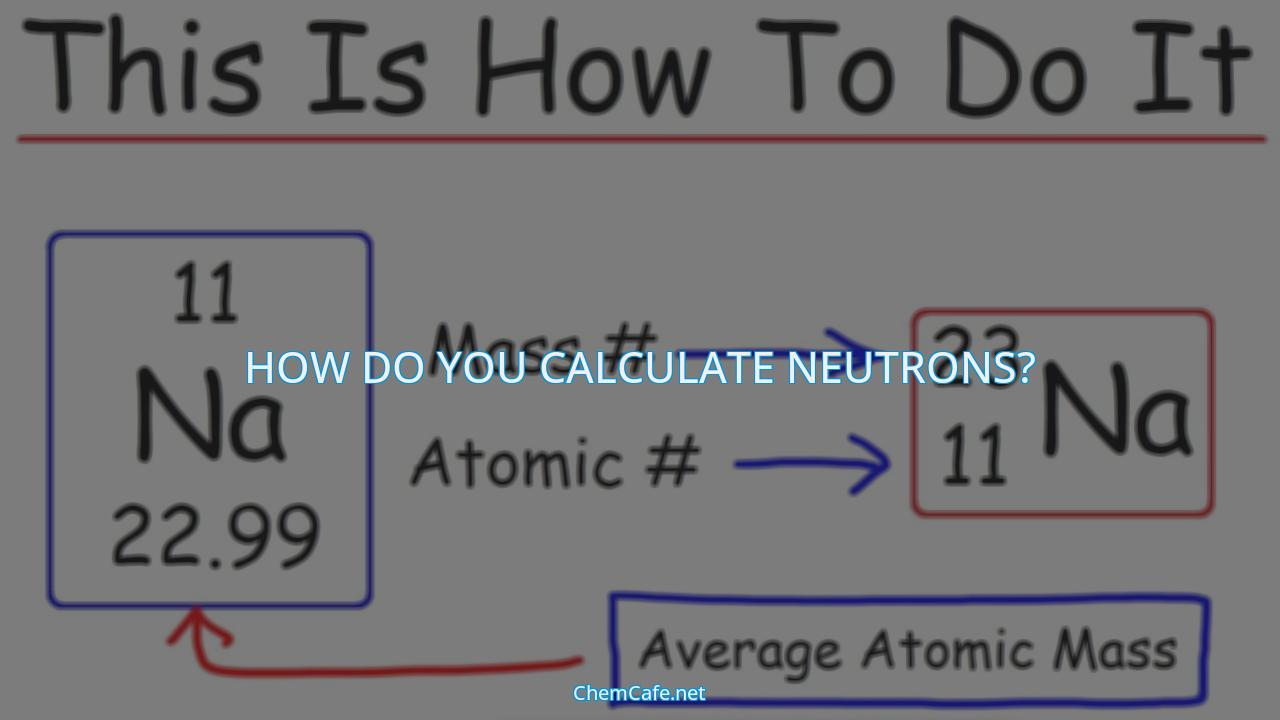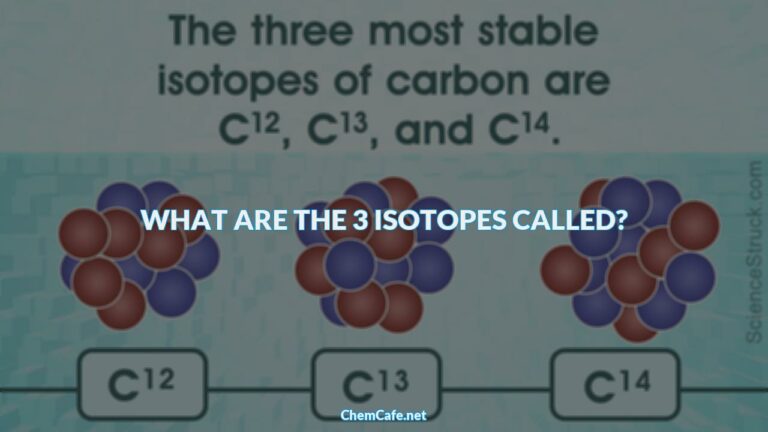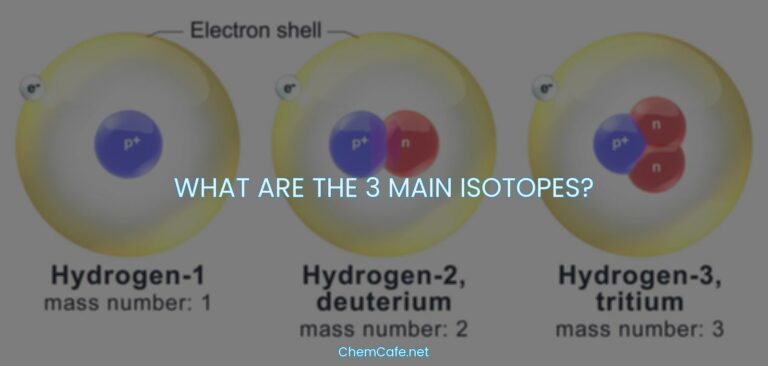The number of neutrons in an atom is a crucial piece of information when it comes to understanding the structure of atoms and making new discoveries. It has long been known that the number of protons and the number of neutrons in a nucleus determine an atom’s mass, but how do we calculate the number of neutrons?
At the most basic level, calculating the number of neutrons in an atom is a simple matter of subtraction. All you need to do is subtract the atomic number (the number of protons) from the atom’s mass number. For example, let’s look at the isotope of copper, Cu-63. It contains 29 protons and has a mass number of 63, as suggested in the name. So, if we subtract the atomic number (29) from the mass number (63), we get 46, which is the number of neutrons in the nucleus of this atom.
But what if you don’t know the atomic mass of an atom? Is there a way to calculate the number of neutrons without having the atomic mass? Fortunately, the answer is yes! All you need to do is use the equation [text{mass number} : A = left( text{number of protons} right) + left( text{number of neutrons} right) nonumber ], which tells us that the mass number is equal to the sum of the number of protons and the number of neutrons.
In other words, if you know the number of protons, you can calculate the number of neutrons without knowing the mass number! This equation can be used to calculate the number of neutrons in any atom.
So, next time you’re trying to determine the number of neutrons in an atom, remember that it’s as simple as subtracting the atomic number from the mass number, or using the equation [text{mass number} : A = left( text{number of protons} right) + left( text{number of neutrons} right) nonumber ] to calculate the number of neutrons without the atomic mass.
How do you calculate neutrons?
Neutrons are particles that are found in the nucleus of an atom, and are responsible for the majority of an atom’s mass. Knowing the number of neutrons in an atom is important for scientists, as it can help them understand the properties of different elements and their isotopes.
The Basics of Neutron Calculation
In order to calculate the number of neutrons in the nucleus of an atom, you must first understand the difference between the atomic number and the mass number of an atom. The atomic number, also known as the proton number, is the number of protons in an atom. The mass number is the sum of the protons and neutrons in an atom.
To calculate the number of neutrons in an atom, you must take its mass number away from its atomic number. For example, take the isotope of copper, Cu-63. It contains 29 protons and has a mass number of 63, as suggested in the name. To calculate the number of neutrons in this atom, you must take its mass number (63) away from its atomic number (29), which leaves you with 46. Therefore, Cu-63 contains 29 protons, and 46 neutrons.
Calculating Mass Numbers
Counting the number of protons and neutrons tells scientists about the total mass of an atom. This is described by the following equation:
[text{mass number} : A = left( text{number of protons} right) + left( text{number of neutrons} right) nonumber ]
An atom’s mass number is very easy to calculate, provided that you know the number of protons and neutrons in an atom.
Example Calculation
Let’s take a look at an example calculation. Suppose we have a helium atom, which has an atomic, or proton number of 2. We also know that this atom has 2 neutrons. To calculate the mass number of this atom, we use the equation above.
[text{mass number} : A = left( text{number of protons} right) + left( text{number of neutrons} right) nonumber ]
For this example, we have 2 protons and 2 neutrons, so the mass number of this atom is 4.
Calculating the number of neutrons in the nucleus of an atom is simple. You take the atomic, or proton number of the element, and you subtract it from the element’s mass number. By doing this, you can easily determine the number of neutrons in an atom.
How do you remember the number of neutrons?
Counting the number of protons and neutrons tells scientists about the total mass of an atom. Mass number (A) is simply the sum of the number of protons and neutrons in an atom. An atom’s mass number is easy to calculate, as long as you know the number of protons and neutrons in the atom.
Example 4.5.1: What is the mass number of an atom of helium that contains 2 neutrons?
For a specific isotope of an element, if we know the mass number of that isotope, we can work out the number of neutrons in an atom of that isotope by subtracting the atomic number (number of protons) from the mass number (total number of protons and neutrons).
Determining the Number of Neutrons
So how do we determine the number of neutrons in a given atom? It is important to understand the following terms:
- Atomic number of an atom is the number of protons in the nucleus of that atom.
- Mass number (also called the nucleon number) of an atom is the total number of protons and neutrons in the nucleus of that atom.
To calculate the number of neutrons in an atom, subtract the atomic number from the mass number. For example, if the mass number of an atom is 14 and the atomic number is 6, then the number of neutrons in the atom is 8 (14 – 6 = 8).
Remembering the number of neutrons in an atom can be difficult, especially when dealing with a large number of elements. To help you remember, you can use the following mnemonic:
PAPA NANA, which stands for Protons + Neutrons = Atomic Number + Mass Number.
This mnemonic is a great way to remember the formula for calculating the number of neutrons in an atom ( Atomic Number + Mass Number – Protons = Number of Neutrons).
Another helpful way to remember the number of neutrons in an atom is to think of it as a “balance”. The number of protons and neutrons in an atom should always be equal, so if you know the number of protons, you can easily calculate the number of neutrons.
Remembering the number of neutrons in an atom can be tricky, but with a few helpful mnemonics and tips, you can easily calculate the number of neutrons in an atom.
How do we calculate neutrons?
Neutrons are an important part of the nucleus of an atom, and understanding how to calculate them is essential for understanding the atomic structure of different elements. Neutrons are uncharged particles that are found in the nucleus of an atom and are essential for understanding and calculating the mass of an atom.
What is the mass number of an atom?
The mass number of an atom is the sum of the number of protons and neutrons in the nucleus. It is represented by the letter A. The mass number of an atom can be calculated by following the equation:
A = (number of protons) + (number of neutrons)
For example, an atom of copper with a mass number of 63 contains 29 protons and 46 neutrons.
How do we calculate the number of neutrons in an atom?
To calculate the number of neutrons in the nucleus of an atom is simple. You take the atomic or proton number of the element and subtract it from the element’s mass number. For example, take the isotope of copper, Cu-63. It contains 29 protons and has a mass number of 63, as suggested in the name. In order to calculate the number of neutrons, you must take its mass number (63) away from its atomic number (29), which leaves you with 46. Therefore, Cu-63 contains 29 protons and 46 neutrons.
What does counting the number of protons and neutrons tell us?
Counting the number of protons and neutrons tells scientists about the total mass of an atom. This is incredibly important in determining the properties of an atom and how it interacts with other atoms. For example, if two atoms have the same number of protons, but different numbers of neutrons, they will have different masses. This is because the mass of a neutron is greater than the mass of a proton.
It is also important to note that the number of neutrons in an atom can vary, even if the number of protons remains the same. This is known as isotopes, and each isotope will have a different mass number.
Conclusion
In conclusion, calculating the number of neutrons in an atom is an important part of understanding the atomic structure of different elements. By understanding the mass number of an atom, the number of protons and neutrons present can be calculated. This information is crucial for understanding the properties of an atom and how it interacts with other atoms.
How do you count neutrons?
Atoms are made up of three main particles: protons, neutrons, and electrons. Protons and neutrons make up the nucleus, or the center of the atom, while electrons orbit the nucleus. The number of protons in an atom determines the type of element it is, while the number of neutrons can vary. Knowing how many neutrons an atom has is important for understanding its properties and behavior. So, how do you count neutrons?
What is the Atomic Mass?
The atomic mass of an element is the sum of the number of protons and neutrons in the nucleus. It is usually expressed in atomic mass units (amu). For example, the atomic mass of Carbon-12 is 12 amu, which means that it contains 6 protons and 6 neutrons. This is also known as the mass number of the atom.
Finding the Number of Neutrons
Once you know the atomic mass of an element, you can find the number of neutrons by subtracting the number of protons (the atomic number) from the atomic mass. For example, Carbon-12 has an atomic mass of 12 amu and an atomic number of 6. This means that it has 6 protons and 6 neutrons.
Isotopes and Neutron Counts
Atoms of the same element may have different numbers of neutrons, which are called isotopes. For example, Carbon-14 has an atomic mass of 14 amu and an atomic number of 6, so it has 8 neutrons. In general, the most abundant isotope of an element has the most neutrons. So, if you want to find the number of neutrons in an atom, you should round the atomic mass to the nearest whole number.
Why Count Neutrons?
Counting the number of protons and neutrons in an atom is important for understanding its mass and behavior. For example, isotopes of the same element often have different chemical and physical properties, which is due to the difference in their neutron counts. Knowing how many neutrons an atom has can help scientists better understand how atoms behave and interact.
In conclusion, counting neutrons is an important part of understanding atoms. You can find the number of neutrons by subtracting the atomic number from the atomic mass and rounding the atomic mass to the nearest whole number. This information can be used to understand the properties and behavior of atoms.
How do you find the number of neutrons without atomic mass?
Atoms are composed of protons, neutrons, and electrons, and understanding their structure is essential for understanding all matter. The mass of an atom is determined by the number of protons and neutrons it contains. Counting the number of protons and neutrons tells scientists about the total mass of an atom. This article will explain how to find the number of neutrons without atomic mass.
What is the Mass Number?
The mass number (A) of an atom is the sum of the number of protons and neutrons in the nucleus. It is often written as the superscript next to the element’s symbol. For example, the mass number of carbon-12 is 12, since it contains six protons and six neutrons.
How to Find the Number of Neutrons?
The number of neutrons in an atom can be determined by subtracting the atomic number (Z) from the mass number (A). The atomic number is the number of protons in the nucleus of an atom. For example, the atomic number of carbon is six, since it contains six protons. Therefore, the number of neutrons in carbon-12 is six (12 – 6 = 6).
Examples of Finding the Number of Neutrons
Let’s look at two examples of how to find the number of neutrons without atomic mass.
Example 1
What is the number of neutrons in a helium atom that contains 2 neutrons?
Solution: The number of neutrons can be determined by subtracting the atomic number (2) from the mass number (4). Therefore, the number of neutrons in the helium atom is 2 (4 – 2 = 2).
Example 2
Use a periodic table to calculate the number of neutrons in a hydrogen atom that contains 2 neutrons.
Solution: The atomic number of hydrogen is 1, so the number of neutrons can be determined by subtracting the atomic number (1) from the mass number (3). Therefore, the number of neutrons in the hydrogen atom is 2 (3 – 1 = 2).
In conclusion, the number of neutrons in an atom can be determined by subtracting the atomic number (Z) from the mass number (A). This knowledge is essential for understanding the structure of atoms and all matter.
How do you find number neutrons?
Neutrons are an essential part of the atom, and understanding how to calculate their number is key to understanding the structure of atoms. Neutrons are found in the nucleus of an atom, alongside protons, and the number of neutrons in an atom can be determined by subtracting the number of protons from the atomic mass. This can be done easily, once the atomic number and the atomic mass of the atom in question are known.
Atomic mass is the total mass of an atom, including both the protons and neutrons. The number of protons in an atom is known as the atomic number, and it is a defining characteristic of the element. Once these two values are known, the number of neutrons in an atom can be determined.
Calculating Neutrons From The Atomic Mass
The atomic mass equals the number of protons plus the number of neutrons, so you find the number of neutrons by subtracting the number of protons (i.e. the atomic number) from the atomic mass (in atomic mass units). Round the atomic mass to the nearest whole number to find the number of neutrons in the most common isotope.
Example: Calculating Neutrons in Copper-63
To illustrate this, let’s take a look at the isotope of copper, Cu-63. It contains 29 protons and has a mass number of 63, as suggested in the name. In order to calculate the number of neutrons, you must take its mass number (63) away from its atomic number (29), which leaves you with 46. Therefore, Cu-63 contains 29 protons, and 46 neutrons.
Calculating Neutrons From Other Isotopes
Atoms of the same element may have different numbers of neutrons, which makes them different isotopes. This is why it is important to know the mass number of the atom when calculating the number of neutrons. For example, let’s look at an isotope of copper with a mass number of 65. This isotope has 29 protons, just like Cu-63, but it has a mass number of 65. Subtracting the atomic number (29) from the mass number (65) gives us 36, so this isotope of copper contains 29 protons and 36 neutrons.
In conclusion, calculating the number of neutrons in an atom is a simple process. All that is required is the atomic number and mass number of the atom in question. Subtracting the atomic number from the mass number will give you the number of neutrons in the nucleus of the atom. Knowing how to calculate the number of neutrons in an atom is a key part of understanding the structure and properties of atoms.





Leave a Comment